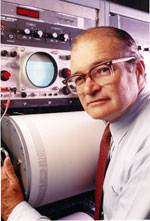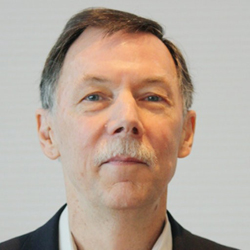 The Bruce Bolt Medal is awarded jointly by the Consortium of Strong Motion Observations Systems (COSMOS), Earthquake Engineering Research Institute (EERI) and SSA to recognize individuals worldwide whose accomplishments involve the promotion and use of strong-motion earthquake data and whose leadership in the transfer of scientific and engineering knowledge into practice or policy has led to improved seismic safety.
The Bruce Bolt Medal is awarded jointly by the Consortium of Strong Motion Observations Systems (COSMOS), Earthquake Engineering Research Institute (EERI) and SSA to recognize individuals worldwide whose accomplishments involve the promotion and use of strong-motion earthquake data and whose leadership in the transfer of scientific and engineering knowledge into practice or policy has led to improved seismic safety.
The following three criteria are used to select the recipient: 1) promotion of strong-motion instrumentation or advancing strong-motion data processing or data utilization, 2) technical contributions in seismic engineering or engineering seismology, and 3) leadership in the transfer of knowledge into practice or policy that has led to improved seismic safety.
The award is issued annually and is presented to the recipient at the annual meeting of the recipient’s choice among the three sponsoring organizations.
Nomination Process
COSMOS, EERI and SSA members are encouraged to nominate a colleague or peer for this prestigious honor.
The annual deadline to submit nominations for the Bruce Bolt Medal is 30 June. Incomplete nomination packages will not be considered by the Joint Selection Committee.
Nomination Materials
A complete nomination package must include the following:
- A nomination letter, written and submitted by the chief nominator. It should be no longer than two pages and must address the ways in which the candidate meets all three of the selection criteria provided below.
- A Curriculum Vitae for the nominee or a substantial summary of the professional history of the candidate, including employment, significant publications, honors, activities and accomplishments relevant to the Bolt Medal criteria.
- The current contact information for the candidate.
- The nomination must be endorsed by three additional individuals, either by adding their signature to the nominating letter or by providing an additional individual letter of support. Such individual letters should include a personal perspective on the nominee and their sustained impact on the field.
- A signed nominator disclosure form submitted by the chief nominator. Click here to complete this form.
Please note, the nomination form requires a google account to submit. If you do not have a google account, you can submit your materials by sending them in an email to boltmedal@eeri.org. For more information about the rules regarding the award, read our Honors Program Guide.
Selection Criteria
In the spirit of Bruce Bolt’s contribution to the science, the chosen recipient must meet all of the below three (3) criteria:
- Promotion of strong-motion instrumentation or advancing strong-motion data processing or publicly-available data utilization;
- Technical contributions in earthquake engineering or engineering seismology; and
- Leadership in the transfer of knowledge into practice or policy that has led to improved seismic safety.
Nominations will be reviewed in confidence by a six-person Joint Selection Committee formed by two representatives from each of the three sponsoring organizations. The recommended nominee will be considered in confidence by each organization’s Board of Directors for their approval and joint selection of the medalist.
- 2024 Selection Committee Members:
- Lori Dengler (SSA)
- Hamid Haddadi (COSMOS)
- Albert Kottke (EERI)
- Ting Lin (Chair of Committee-EERI)
- Alberto Michelini (SSA)
- Carlos Ventura (COSMOS)
Any questions regarding this award should be sent to boltmedal@eeri.org.
2025 Bruce Bolt Medalist

Kenneth W. Campbell of CoreLogic Inc. (retired) is the recipient of the 2025 Bruce Bolt Medal.
Campbell was recognized for his 50 years of research and practice-oriented contributions to earthquake hazard and risk characterization and his innovative and impactful utilization of earthquake ground motion data..
He has been a leader at several professional organizations, including CoreLogic Inc. and EQE International/EQECAT, focused on seismic hazard and risk analysis used in the insurance industry. His career also includes work for the U.S. Geological Survey and consulting companies specializing in developing design ground motion for worldwide critical facilities and oil platforms.
He is perhaps best well-known for his impactful studies in ground motion modeling, several of which were cited by his peers in their nomination of Campbell for the Bolt Medal. These groundbreaking papers include the 1981 Bulletin of the Seismological Society of America paper “Near-Source Attenuation of Peak Horizontal Acceleration,” which introduced the concept of magnitude saturation of peak ground acceleration; and the 2003 BSSA paper “Prediction of Strong Ground Motion Using the Hybrid Empirical Method and Its Use in the Development of Ground-Motion (Attenuation) Relations in Eastern North America,” which pioneered the concept of the “hybrid-empirical method” for developing ground motion models in regions with sparse ground-motion recordings.
